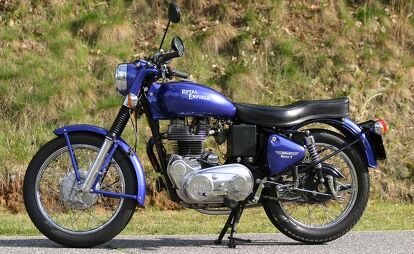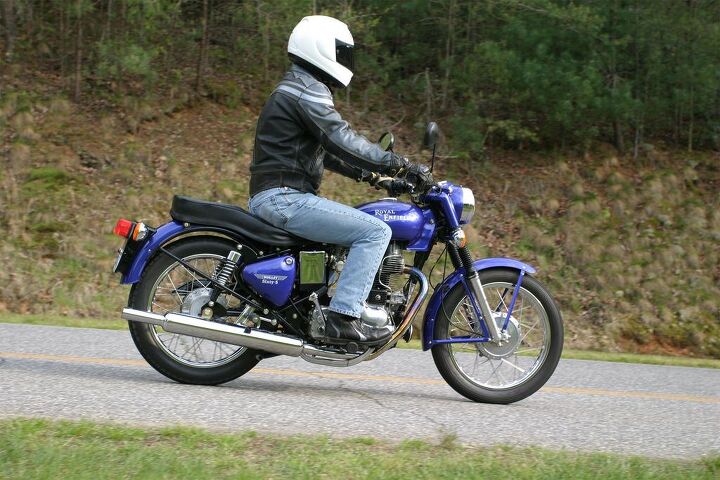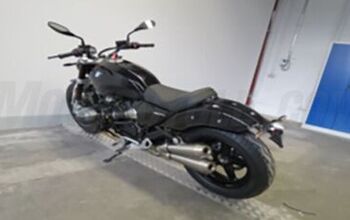Church Of MO – Royal Enfield Bullet Sixty-5 Riding Impression

A quick glance at the MO front page will reveal an overload of sportbike-related material this week. From Chief Editor Duke’s third installment of racetracks he’s ridden, to my very own review of the game-changing 2015 Yamaha YZF-R1 and R1M, I realize MO seems a little sportbike heavy. In response, let’s change gears and focus our attention at this, the Royal Enfield Bullet Sixty-5. Where the aforementioned Yamaha is entirely tech-focused, the Sixty-5 is firmly planted in the 1950s. One cylinder, two valves, pushrods and carburettors… tech that wasn’t particularly impressive even 60 years ago. However, these things run like tanks, and if you go to Royal Enfield’s Indian home you’ll likely see plenty of these running around.
Instead of traveling abroad, we’ll instead travel back in time, 2006 to be exact, to this ride report of the Sixty-5 from contributor Patrick Barnett. Hear his thoughts as he pilots a motorcycle virtually unchanged from what his father, or grandfather even, might have ridden. Also, don’t forget to visit the Sixty-5 photo gallery for more pictures.
Royal Enfield Bullet Sixty-5 Riding Impression
“What in the world is a Royal Enfield Bullet Sixty-5?”
That’s a question I was asked many times while I was testing this bike here at my western North Carolina home. To get the full story it is necessary to go back not just to the last century, but to 1898. Royal Enfield initially began producing bicycles, before building their first motorcycle in 1900. These early machines were fitted with donor engines, and it wasn’t until 1927 that the British company began manufacturing their own engine: a 488cc single cylinder with a four-speed gearbox.
1932 saw the first Bullet and over the next thirty or so years, this simple single underwent continued improvement and refinement. During this time the company made a number of different motorcycles, even selling various singles and twins under the Indian name from 1955 to 1959 here in America. By 1962 the company had been sold and the new owners lasted just eight years under the onslaught of Japanese motorcycles flooding into the country. And that would have been the end of the once-proud company, had it not been for a strange twist of fate.
In 1954, the Indian government placed an order to purchase 800 Royal Enfields for duty along the Pakistani border. The simple, rugged single proved to be very successful in the harsh terrain and similar orders were placed for 1955 and 1956. Filling orders of this magnitude was no easy task for the small British company, so a factory was established in India to meet the demand. The Enfield India, Ltd. company was born, and close to fifty years later, 20,000 bikes still roll out of the factory every year. The new motorcycles look nearly identical to the bikes originally produced in 1956; very little change has actually occurred. Technology has crept in over the years, with improved metallurgy, new machining techniques and more durable parts. Major changes include the new five-speed gearbox — which now shifts on the left — the electric starter and 12-volt electrics.
The heart of the Royal Enfield remains the same though, with a 499cc piston thumping up and down beneath you. The two valves are opened and closed by pushrods, and a single 28mm carburetor adds fuel to the cylinder. With a 5.5:1 compression ratio, don’t expect a big explosion during the old suck, squeeze, bang, blow cycle.(I’ve never heard internal combustion — or anything except pornography — described like this. -Ed.) What you get with the Bullet is a rhythmic sucking sound followed by a gentle exhale as the piston comes wandering back up to top dead center to expel the burned gas.
Power is transmitted to the rear wheel through a five-speed gearbox via a chain drive. This is new for Royal Enfield; earlier models used a four-speed unit. I have ridden Enfields with both right and left foot shift and can safely say they are both as bad as each other, making gear selection something of a minor adventure.
I am happy to report there has been major progress in the new gearbox. It can still make you work for top gear on occasion, but for the majority of the time it shifts very sweetly and makes the whole process of downshifting one of the most fun parts of the Enfield experience. Zipping up the mountain to my house one day, I was reminded of a paragraph I wrote about riding an Enfield across the Himalayas of Northern India a few years ago, and due to the large smile it brought back to my face, I thought I would share it with you.
“The Enfield itself was a bit of a cantankerous old beast. Treat her with love and affection, gently nurture her along and she would perform just fine. Ask her to start in a hurry from cold, or change down from second to first on a steep, blind, hairpin turn and it was a definite “No!” There was a rumor that my Enfield had four gears and a front and rear brake. In reality, there was a back brake, and on the odd occasion when the moon was in correct alignment, she had all four gears.”
In defense of the machine, the bike I rode in India was badly beaten, and the Royal Enfields on sale here in America since 1995 are in a different league. After a long winter of neglect at some dealership up north, the Enfield that arrived at my house a couple of months ago needed to be checked into Precision Cycle of Sylva, North Carolina for some necessary rehab. Once there, my buddy Jeff replaced a broken push rod tube, a bad battery and dead starter solenoid, before lubing, adjusting and tweaking all the bike’s important little places. Arriving one beautiful spring day to find the bike starting on the touch of the button — or one very easy kick — I roared off in search of adventure on the smallest, quietest back roads I could find.
With the sun shining down through the partial foliage, the Enfield was in its element as we pottered along the lazy Tuckaseegee River. Fly fishermen in tire rafts bobbed in sparkling patches of light, gently tempting their prey in the cool dark pools along the riverbank. As the Enfield settled into a lazy, huffing beat, I breathed a little deeper, sighed a long sigh and absorbed the natural beauty of my local area. Slowly unwinding, I found the Bullet’s sweet spot as we swung gently back and forth through the tight bends. I had softened the rear suspension and on the smooth road it was treating me just fine. Setting up early for the corners and planning my braking well in advance, I spent an enjoyable few hours meandering on the lightly-trafficked roads.
With the stock bike producing a whopping 22 horsepower, I was most interested to see there is a high-compression, big-bore piston kit available for $435, which should liberate a few more ponies. Dreaming of an ideal world, I would also order up the new “miracle” clutch, a less-restrictive exhaust pipe and the 32mm Amal carburetor kit. Then I would go talk nicely to my buddy Jeff for one of his infamous head jobs (Let me guess how that goes…suck, squeeze, bang, blow? -Ed.) to complement the larger, higher-compression piston and bigger carburetor. While the checkbook was out, I would go for new shocks and fork springs. These changes, not counting labor, would run around $1,500, which is really not too bad especially when I think how much just a full exhaust system costs for a modern bike these days.
This is not to say the stock motorcycle can’t be enjoyed exactly as it is. It’s just not a modern Japanese motorcycle and life with Mr. Enfield is a going to be a very different experience than life with your average UJM. For instance, just the simple act of starting the bike requires a different approach. First, the fuel tap needs to be turned on, next the choke lever depressed and then, if you are feeling really retro, the decompression lever pulled as you kick the piston through its cycle to the correct place. This is a little past top dead center on the compression stroke, or when the amp meter located next the speedometer is in the middle position. Then let the kick start lever back to the top, take a good swing and give just the slightest whiff of throttle when the lever is all the way at the bottom of its stroke. Using this method, the trusty thumper will start first kick every time.
The bike is very cold blooded by nature, and you have to leave the choke on for a while, but once warmed up it will idle away merrily, although to the uninitiated ear it sounds as if it is about to stall as the piston putters up and down at an extremely low speed. Once underway, the bike doesn’t so much accelerate as it does steadily make progress as it gathers speed. It can just about keep pace with traffic on two-lane roads, and will travel at between 60-70mph out on the highway, depending on how much vibration you can stand.
But if you keep the speeds under 55mph and stay off the beaten track you will be rewarded with one of the most unique experiences to be found on two wheels. It’s a bike that is impossible to park without getting into conversation and it is a good idea to carry some paper work to convince the people who can’t grasp the fact that it is actually brand new. Priced at $4,895, the entry price to a totally unique motorcycle experience is not high. And with a host of readily-available parts for the compulsive tinkerer to improve and upgrade his ride, the Royal Enfield Bullet Sixty-5 is going to be an extremely fun addition to the garage for those who take one home.

Troy's been riding motorcycles and writing about them since 2006, getting his start at Rider Magazine. From there, he moved to Sport Rider Magazine before finally landing at Motorcycle.com in 2011. A lifelong gearhead who didn't fully immerse himself in motorcycles until his teenage years, Troy's interests have always been in technology, performance, and going fast. Naturally, racing was the perfect avenue to combine all three. Troy has been racing nearly as long as he's been riding and has competed at the AMA national level. He's also won multiple club races throughout the country, culminating in a Utah Sport Bike Association championship in 2011. He has been invited as a guest instructor for the Yamaha Champions Riding School, and when he's not out riding, he's either wrenching on bikes or watching MotoGP.
More by Troy Siahaan










































Comments
Join the conversation
I once rode a BSA 350 and the experience was comparable, except that when I stopped for a rest it failed to restart. And I normally rode a kick start Honda 350 single. I may have been confused between the compression release lever and the spark advance lever. It was very nice while in motion. And I never really relied too much on the front brake...
Never heard of suck, squeeze, bang, blow??? You're in the motorsports field and never heard of this? You must be very young. No wonder we're being bombarded with 'electric motorcycles'. They are NOT the answer. Your should go out and learn to change the oil on anything and get your hands dirty.